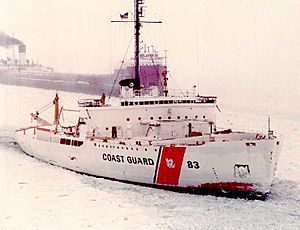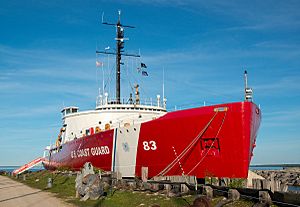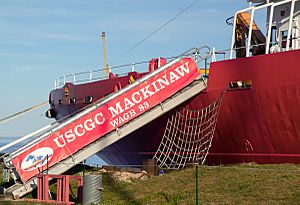USCGC Mackinaw (WAGB-83) facts for kids

USCGC Mackinaw
|
|
Quick facts for kids History |
|
|---|---|
| Name | USCGC Mackinaw |
| Namesake | Mackinaw City, Michigan |
| Builder | Toledo Shipbuilding Company, American Ship Building Company |
| Laid down | March 20, 1943 |
| Launched | March 4, 1944 |
| Commissioned | December 20, 1944 |
| Decommissioned | June 10, 2006 |
| Identification |
|
| Status | Museum ship |
| General characteristics | |
| Displacement | 5,252 long tons (5,336 t) |
| Length | 290 ft (88 m) |
| Beam | 74.3 ft (22.6 m) |
| Draft | 19.5 ft (5.9 m) |
| Propulsion |
|
| Speed | 15 kn (28 km/h; 17 mph) |
| Capacity |
|
| Complement |
|
The USCGC Mackinaw (WAGB-83) was a special United States Coast Guard ship called an icebreaker. It worked on the Great Lakes for 62 years, helping ships move through icy waters. When it was built in 1944, during World War II, it was a very advanced ship. Its main job was to keep shipping routes open during winter, which helped the United States' economy. Unlike other large Coast Guard icebreakers, the Mackinaw was made just for the shallow, fresh waters of the Great Lakes.
For its entire time with the Coast Guard, the Mackinaw was based in Cheboygan, Michigan. It traveled to Lakes Superior, Huron, Michigan, and Erie to break ice. This kept shipping lanes and harbors clear for other vessels. The Mackinaw was taken out of service in 2006 because it cost a lot to run. After that, it sailed to Mackinaw City, Michigan, where it became a museum called the Icebreaker Mackinaw Maritime Museum.
A smaller, newer Coast Guard ship, also named Mackinaw (USCGC Mackinaw (WLBB-30)), replaced the old one. This new ship is also based in Cheboygan.
Contents
Building the Mackinaw
In 1941, the United States Coast Guard studied a Soviet icebreaker called the Krassin. This helped them design new icebreakers, including the Mackinaw. They also learned from a modern Swedish icebreaker called the Ymer. Even the icebreaking features of train ferries that worked in the icy Straits of Mackinac were studied. The final design for the Mackinaw was created by naval architects Gibbs & Cox.
The Mackinaw started being built on March 20, 1943, in Toledo, Ohio. The company building it, Toledo Shipbuilding Company, had trouble with such a big project. The ship took too long to build, and the company went out of business. Another company, American Ship Building Company, took over. The Mackinaw was launched sideways into the water on March 4, 1944. It officially joined the Coast Guard on December 20, 1944. Many women in the Toledo area helped build the ship because many men were away fighting in the war. The Mackinaw cost about $10 million to build, which was a lot of money back then.
The Mackinaw's design is similar to other powerful icebreakers called the Wind class. However, it was built specifically for the Great Lakes. It was made longer and wider than ocean icebreakers so it could float in the shallower lake waters. Its cooling system uses fresh lake water directly for its engines.
The Mackinaw's hull (the ship's body) is very strong. It has a double hull, meaning two layers of steel with space in between. This space is filled with fuel and ballast tanks. Water can be quickly pumped into and out of these ballast tanks. This makes the ship rock from side to side, which helps it push ice away from its sides.
The Mackinaw had two propellers at the back and a special propeller at the front. The front propeller pulled water from under the ice. When the ship rode its bow (front) onto the ice, the unsupported ice would break into the hollow space created by the propeller. The moving water from the front propeller also helped the ship slide through the ice. The Mackinaw could break through thick, solid ice and even huge piles of broken ice. Its sides were protected by an "ice belt" of very thick steel plating.
Each of the three propellers had its own electric motor. These motors were powered by six large diesel engines. The ship's electrical system allowed power to be sent to the propellers in different ways, depending on whether it was breaking ice or cruising in open water.
What the Mackinaw Did
The Mackinaw was built to help ships keep moving on the Great Lakes during World War II. Before the Mackinaw, ice would stop shipping from late December until spring. The Coast Guard knew that keeping the shipping season open for just ten more days could help deliver millions of tons of important materials like iron ore and grain.
Early Years (1945-1960)
After it was launched, the Mackinaw first helped train Soviet sailors in early 1945. After the war, it continued its icebreaking duties on the Great Lakes. It was the largest icebreaker on the lakes at that time. The Mackinaw and other Coast Guard ships helped freighters carry their cargo, like taconite and grain, to cities like Detroit and Chicago.
The Mackinaw's icebreaking season usually lasted about 70 days, from mid-December until the ice melted in spring. It would clear paths through the ice in places like Whitefish Bay, the St. Marys River, and the Straits of Mackinac. It also helped ships stuck in ice in harbors like Buffalo. For example, in 1947, the Mackinaw helped free many ships trapped in Buffalo harbor.
The Mackinaw was not usually involved in search and rescue missions, as smaller, faster ships handled those. However, it did help in a big search after Northwest Orient Airlines Flight 2501 disappeared over Lake Michigan in 1950. The crew searched for survivors and collected airplane parts.
Its powerful engines also made it good for towing large ships in trouble. In 1945, it towed the U.S. Navy ship USS Elusive after its propeller was damaged by ice. In 1956, it helped tow the grain carrier J. P. Wells, which was caught in a storm on Lake Superior.
During the building of the Mackinac Bridge from 1954 to 1957, the Mackinaw played an important role. It cleared away large pieces of ice that piled up against the bridge's foundations. This allowed the bridge to be built without the ice causing problems.
Later Years (1960-2006)
In 1960, the freighter SS Francisco Morazan got stuck in a snowstorm on Lake Michigan. The Mackinaw arrived to help, rescuing the captain's wife and later the entire crew as the ship began to break apart.
In 1965, the Mackinaw was in charge of rescue efforts after a ship called MV Topdalsfjord crashed into and sank the SS Cedarville near the Mackinac Bridge. The Mackinaw's crew pulled people from the water and took on survivors.
In 1966, the German freighter MV Nordmeer ran aground in Lake Huron. The Mackinaw rescued most of the crew. Later, when a storm hit, a Coast Guard helicopter airlifted the remaining crew members to the Mackinaw.
In 1967, the Mackinaw traveled through the Welland Canal to visit Montreal for the Expo 67 world's fair. This showed that the ship could now leave the Great Lakes because the Saint Lawrence Seaway had been expanded. It also visited Toronto in 1986 and 2002.
In 1976, the ore carrier Cliffs Victory got stuck in the Saint Marys River due to ice. The Mackinaw and other tugboats worked for days to free it. This caused a huge traffic jam of over 60 ships waiting to pass.
In 1984, a big ice jam formed in the St. Clair River, blocking shipping for weeks. The Mackinaw, along with other U.S. and Canadian icebreakers, led convoys of ships through the ice. Thousands of people watched this "ice jam of the century" from the river banks.
In 1991, the Mackinaw welcomed its first female sailors. In 1998, its hull was repainted from white to red, matching other Coast Guard icebreakers.
As the years passed, the Mackinaw became very expensive to keep running. The Coast Guard had planned to take it out of service several times before, but shipping companies and Congress always objected. Finally, in 2000, the Coast Guard started looking for a new ship to replace it. The annual cost to maintain the Mackinaw was over $4 million.
In 2004, a group called the Icebreaker Mackinaw Maritime Museum (IMMM) was formed. They wanted to turn the Mackinaw into a museum after it was taken out of service. They worked with government officials to make this happen.
On June 10, 2006, the Mackinaw was officially taken out of service in Cheboygan. A new Coast Guard icebreaker, also named Mackinaw, was put into service on the same day. On June 21, the old Mackinaw sailed to its new home in Mackinaw City. It docked at the old railroad pier, where it became the Icebreaker Mackinaw Maritime Museum. The museum opened to visitors in 2007.
The Mackinaw as a Museum
The Icebreaker Mackinaw Maritime Museum is located at the eastern end of the old SS Chief Wawatam railroad dock in Mackinaw City. Visitors can take educational tours and even stay overnight on the ship! You can explore many areas, including the mess deck (where sailors ate), the captain's quarters, the bridge (where the ship was steered), the engine room, and the sick bay. There's also a gift shop on board. While there's a fee for visitors, all current and former U.S. Coast Guard members can enter for free.
Amateur Radio Station
A group of amateur radio enthusiasts has set up a full-time radio station on board the museum ship. This station uses the call sign W8AGB, which matches the ship's WAGB-83 designation. They have special radio equipment and antennas on the ship.
Amateur radio operators who visit the Mackinaw can use the W8AGB station when a group member is present. The group also holds special "Amateur Radio Field Day" events from the Mackinaw every June.
Awards and Honors
The USCGC Mackinaw received several awards for its service:
- American Campaign Medal
- World War II Victory Medal
- National Defense Service Medal with three service stars
- Global War on Terrorism Service Medal




